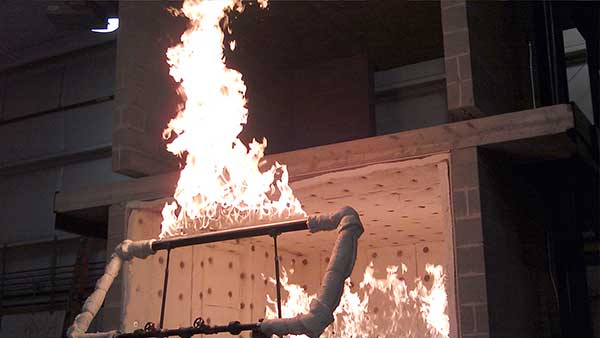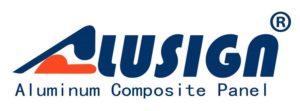- [email protected]
- 0086-18516251697
- Mon - Sun 0:00-24:00

The fireproof rating of aluminum composite panels is determined by two indicators, namely the national mandatory standard GB8624 “Building materials combustion performance classification method” and GB/T17748 “aluminum composite panel” national standard requirements. The combustion performance of building materials in China is graded as follows:
Class A: Non-combustible building materials
Class B1: Flame retardant building materials
Class B2: Combustible building materials
Class B3: Flammable building materials
The common core material of aluminum composite panel is low-density ordinary polyethylene, which will generate more smoke in the fire. Therefore, the fire-rated performance of aluminum composite panel has always been a focus of attention.
In the past, many countries and many manufacturers have conducted extensive experiments on the fire performance of low-density ordinary polyethylene-plastic composite panels. The experimental research includes the burning test of low-density polyethylene, the burning test of low-density polyethylene sandwiched between aluminum-plastic panels, and the analysis of the condition of aluminum composite panel after fire.
The results of the low-density polyethylene burning test show that the polyethylene can be ignited by an open flame (ASTMD1929 and DIN54836) at an ignition temperature of 341 ° C; the polyethylene can be self-ignited (ASTMD 1929 and DIN 54836) at an auto-ignition temperature of 349 ° C. Polyethylene must be ignited or self-ignited when it reaches the above temperature and has a large amount of oxygen (ie, air).

1.Any heat generated will spread quickly. Therefore, for pure polyethylene itself, the heat applied to the aluminum composite panel during the fire does not reach the temperature at which it is ignited or self-ignited.
2.The oxygen passage to the polyethylene surface was severely cut off, and therefore, the polyethylene in the aluminum composite panel was not exposed to the air. Therefore, when the aluminum plate is not melted, the burning of the polyethylene does not occur.
When the flame is very close to the aluminum-plastic plate, and the temperature reaches the temperature at which the aluminum melts (60 ° C), the polyethylene burns.
3.When polyethylene is burned, only carbon (C) and hydrogen (H) are burned, and the compounds are carbon monoxide (CO), carbon dioxide (CO2), water (H2O), and some hydrocarbon gases.
Different from other plastics. Polyethylene does not contain nitrogen or sulfur, so when burned, it does not produce toxic hydrogen sulfide, hydrogen peroxide, hydride and chloride. The gas produced during combustion mainly contains soot (carbon black) and carbon dioxide ( CO2), water vapor and unburned polymer particles.
The above test and the analysis of the results are only manufacturer’s own point of view, but it is undeniable that when the aluminum composite panel is used for the curtain wall, the smoke generated by the polyethylene core material is less harmful due to diffusion and dilution.
Used in the case of interior decoration. Despite this, in order to be safe, many countries have restricted the use of common corealuminum composite panel. In high-rise buildings, aluminum-plastic composite panels are recommended to use non-combustible core materials.

In China, the state has put forward requirements for fire safety performance, especially for some crowded public places, such as airports, stations, stadiums, theaters, high-end entertainment venues and high-rise buildings, etc., the decorative materials selected must meet the fire protection requirements.
As a kind of new decorative material with wide application, aluminum composite panel attaches great importance to its fireproof performance. The National Fireproof Building Materials Quality Supervision and Inspection Center tests and classifies the fire safety performance of aluminum composite panel according to GB8624 “Classification Method of Combustion Performance of Building Materials”.
And the United Nations acp cladding quality supervision and inspection center, jointly implement the quality supervision of fire-resistant acm panels. The fireproof performance of mainly refers to the flame retardant performance of polyethylene plastic core board.
Due to the uniqueness of its chemical structure, most plastic products are flammable products. The relevant domestic units have developed safe and effective flame retardants for the combustion mechanism of polyethylene according to fire protection regulations, ensuring the technical performance of aluminum composite panels.
Under the premise, the fireproof performance of the acm materials meets the technical requirements of the nationally required combustion performance B1 grade, and creates conditions for mass production of fire-resistant aluminum composite panels for specific occasions.
According to the national standard “Code for Fire Protection of Building Design” (GBJ16), the wall material should be B1 (flammable material) or A (non-combustible material). The evaluation of the grade is in accordance with the national standard “Classification Method for Combustion Performance of Building Materials” (GB8624-1997). At present, the fireproof aluminum composite panel produced by most domestic enterprises has a fire rating of B1.

#acm material #acm panel suppliers #acp cladding #acp panel #acp panel pricing #acp sheet #alucobound #aluminum composite panel #Alusign #am panel
click to fill in the contact form then our sales manager will contac you asap
Alisugn Aluminum Composite Panel | All Rights Reserved by AlusignDesign & Developed by VW Themes
WhatsApp us
